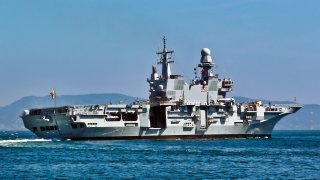Did You Know: Italy Has an Aircraft Carrier That Can Fly F-35 Fighters
Laid down in 2001 and commissioned in 2008, the Cavour serves as Italy’s sole aircraft carrier, capable of carrying F-35B fighters, AV-8B Harriers, and helicopters.
Summary: The Italian Navy's participation in the Rim of the Pacific 2024 exercises marks a significant expansion of its focus beyond the Mediterranean. The flagship, the Cavour Carrier Strike Group, will deploy to the Indo-Pacific region for the first time. Laid down in 2001 and commissioned in 2008, the Cavour serves as Italy’s sole aircraft carrier, capable of carrying F-35B fighters, AV-8B Harriers, and helicopters.
Key Points About Italy's Aircraft Carrier
-Designed for both military and civilian transport, it boasts advanced missile systems and navigation technology.
-The Cavour's operational history includes earthquake relief in Haiti and F-35B trials, enhancing Italy's naval capabilities.
One Key NATO Ally Has an Impressive Aircraft Carrier: Meet the Cavour
Earlier this year, the Italian Navy announced it would participate in the Rim of the Pacific 2024 joint naval exercises. This biannual event is the world’s largest set of military drills, and it usually caters to navies from the Indo-Pacific region.
Italian Naval Attache Capt. Marco Bagni earlier this year noted that the country planned to deploy the Cavour Carrier Strike Group to the region for the first time.
Bagni acknowledged that, like other European navies, Italy is striving to expand its focus outside of its traditional area of responsibility – in Italy’s case, the Mediterranean. As the flagship of the Italian Navy, the Cavour’s plans in the region are significant.
A Brief History of the Cavour
Italy’s sole aircraft carrier was laid down in 2001 by local manufacturer Fincantieri. Three years later, she was launched from the Riva Trigoso shipyard at Sestri Levante. By 2008, Cavour was commissioned and soon reached full operational capability with the Italian Navy.
The warship was designed to serve as an aircraft carrier, in addition to being able to transport tracked and wheeled vehicles for both military and civilian purposes. The carrier has a displacement of nearly 28,000 tons but can reach more than 30,000 tons at full capacity.
The Italian carrier is fitted with two Sylver Vertical Launching Systems for the Eurosam SAMP/T missile system, which can fire Aster missiles. As detailed by Naval Technology, “The Aster 15 missile has a 13kg warhead and a range of 30km. The missile’s guidance is inertial with data uplink and active radar terminal homing. For increased maneuverability in the terminal phase, the missile uses a ‘PIF-PAF’ direct thrust control system with gas jets.”
The Cavour can carry an array of aircraft that can take off and land on short runways. These include the F-35 Lightning II’s Short Take-Off and Vertical Landing variant, AV-8B Harriers, and a dozen helicopters.
The carrier is able to support landing operations via its AN/SPN-41A radio frequency instrument approach landing system and the Galileo Avionica SPN-720 advanced Precision Approach Radar. Additionally, the warship is equipped with the Thales tactical air navigation system. A combined gas turbine and gas (COGAG) propulsion powers the Cavour.
Operational History
The Cavour was first deployed to provide earthquake relief in Haiti. A full decade later, the Italian carrier would sail to the U.S. where it would conduct trials with the F-35B. These trials were deemed successful, and F-35B training was officially completed in 2021. One year later, the Cavour took part in training operations alongside the American carrier Harry S. Truman and the French carrier Charles de Gaulle.
The American-made F-35 fighter is widely considered one of the best aircraft to fly the skies today. Italy’s ability to field F-35Bs from its sole aircraft carrier is an asset to the country.
About the Author: Maya Carlin
Maya Carlin, National Security Writer with The National Interest, is an analyst with the Center for Security Policy and a former Anna Sobol Levy Fellow at IDC Herzliya in Israel. She has by-lines in many publications, including The National Interest, Jerusalem Post, and Times of Israel. You can follow her on Twitter: @MayaCarlin.
All images are Creative Commons.


